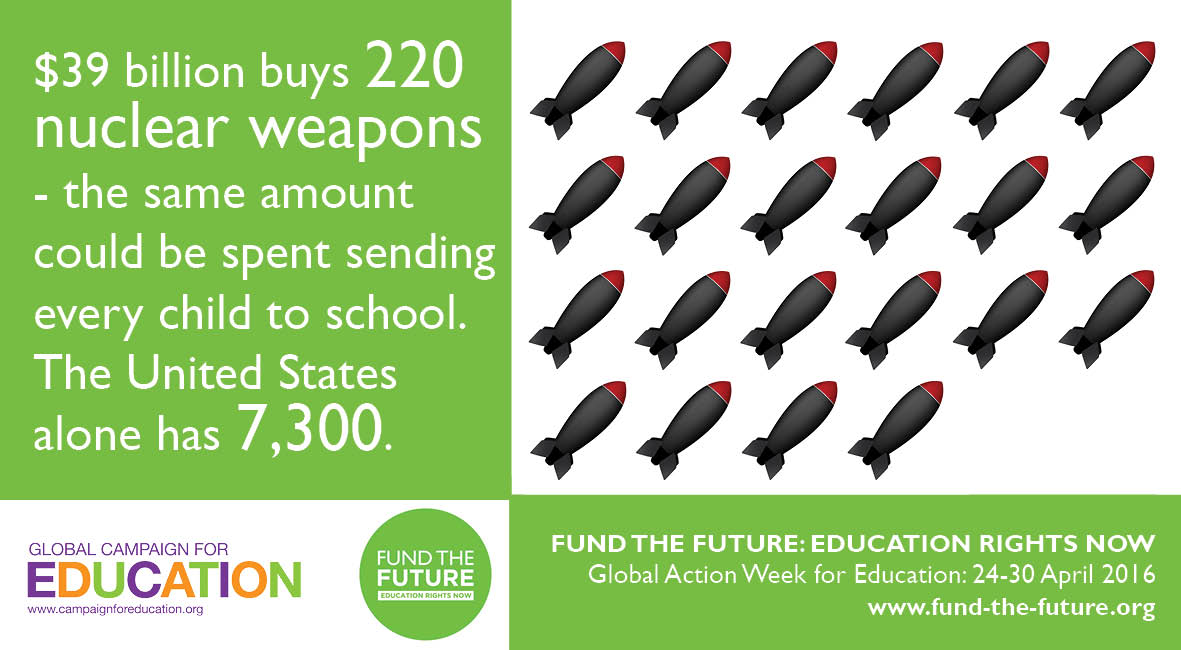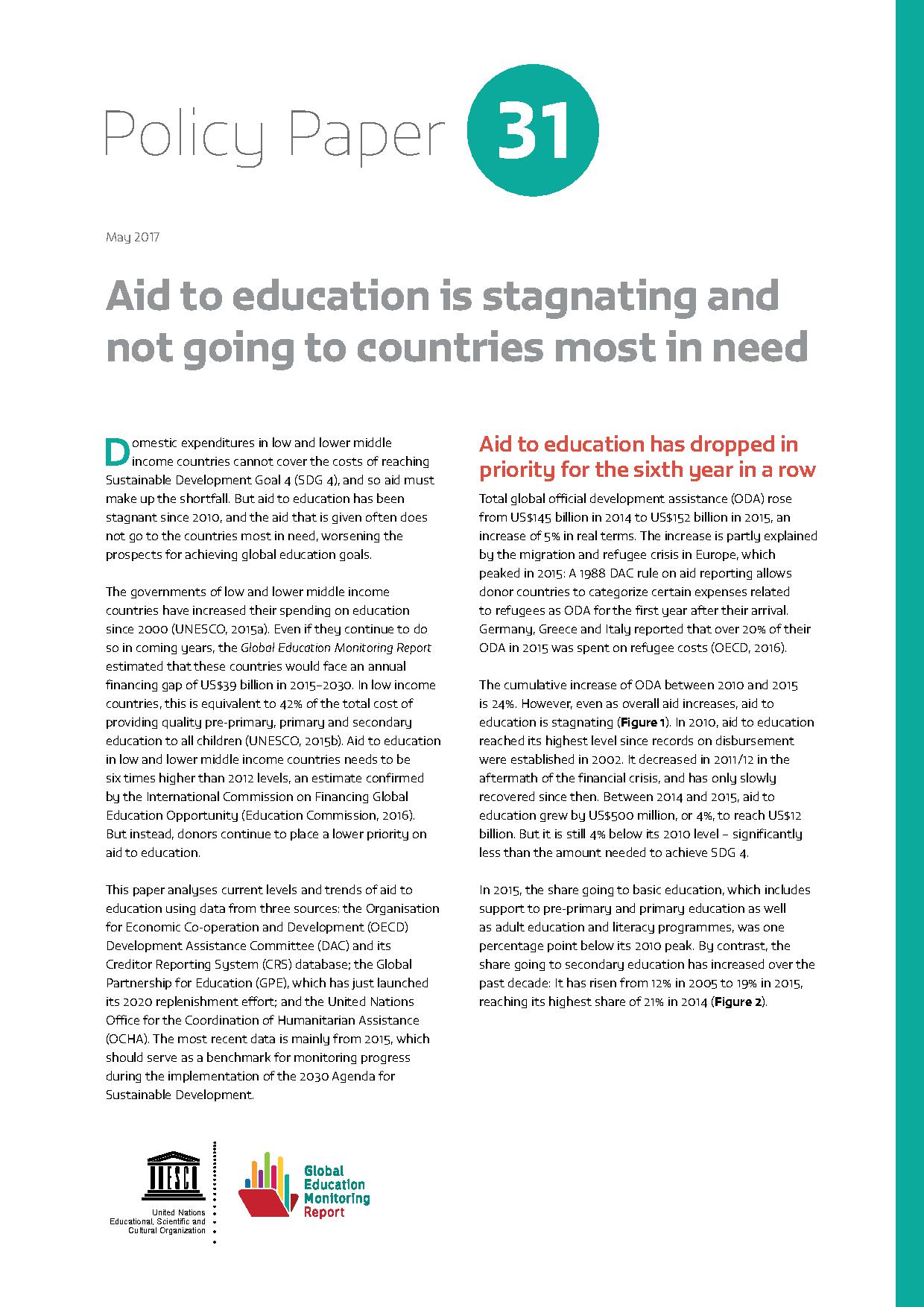GAWE 2016 | Fund the Future!
De laatste paar jaar neemt het aantal kinderen dat geen toegang heeft tot onderwijs weer toe. Volgens de laatste gegevens gaat het nu om 59 miljoen kinderen. In eerdere rapporten berekende UNESCO dat er jaarlijks 39 miljard dollar aan extra financiering nodig is – naast wat ontwikkelingslanden nu al zelf in onderwijs investeren – om ten minste 12 jaar goed onderwijs voor iedereen te kunnen garanderen. Dat betekent dat de onderwijshulp zes keer meer zou moeten zijn dan het nu is. In plaats daarvan is die wereldwijde onderwijshulp 8% lager dan in het jaar 2010. Tussen 2013 en 2014 verlaagden vier donorlanden, waaronder Nederland, hun hulp aan basisonderwijs met 40%. Zelfs het Verenigd Koninkrijk, een van de belangrijkste onderwijsdonoren, verlaagde de hulp aan basisonderwijs met een vijfde (21%).

Niet eerlijk verdeeld
Dat maakt het voor landen die nog deels afhankelijk zijn van ontwikkelingshulp nagenoeg onmogelijk om de onderwijsdoelen te realiseren. In de praktijk blijken de landen die de hulp het hardste nodig hebben, het minste te krijgen. In 2002 kreeg zuidelijk Afrika nog zo’n 49% van alle onderwijshulp; in 2014 was dat percentage gedaald naar 28%. Terwijl in deze regio meer dan de helft van alle kinderen die niet naar school gaan woont.
Ook is de onderwijshulp per kind niet eerlijk verdeeld. Zo kreeg Mongolië, waar 97% van de kinderen de basisschool afmaakt, 45 dollar per kind aan onderwijshulp. Tsjaad daarentegen, waar nog geen 30% van de kinderen de basisschool afmaakt, ontving slechts 3 dollar per kind aan onderwijshulp.
Fund the Future
Het is dan ook geen wonder dat de GCE in 2016 voldoende geld voor onderwijs koos als het thema van de jaarlijkse Global Action Week on Education. Onderwijscoalities in tal van landen, zowel westerse landen als ontwikkelingslanden, grijpen de GAWE aan om campagne te voeren voor het recht op onderwijs. Dat varieert van activiteiten op en met scholen tot evenementen of lobbyactiviteiten.

Nieuwe cijfers over onderwijshulp
Volgens de meest recente cijfers van het Global Education Monitoring Report daalde de internationale onderwijshulp tussen 2013 en 2014 met 4%. Landen die de hulp hard nodig hebben, kregen 600 miljoen US dollar minder. Het aandeel van internationale hulp dat voor onderwijs is bestemd, is ook gedaald: van 9,5% naar 8,2%. Het laat zien dat onderwijs bij donoren steeds minder prioriteit heeft.
Meer weten over financiering van onderwijs
» Education Aid Watch Report 2015
GCE analyseert de onderwijshulp van de belangrijkste donoren voor de periode 2000-2015.
» UNESCO Institute for Statistics
Het UIS verzamelt en analyseert data over financiering van onderwijs. De database is vrij toegankelijk.
» WorldBank
De Wereldbank verzamelt gegeven over financiering van onderwijs. De database is vrij toegankelijk.
» Global Partnership for Education
Multilateraal partnerschap specifiek voor de financiering voor onderwijs wereldwijd.
» Education Commission
Nieuwe internationale commissie die streeft naar meer fondsen en effectievere investeringen in onderwijs.
» Government Spending Watch
Database van overheidsuitgaven van 74 lage- en middeninkomenlanden voor de MDGs en SDGs.
Waar de GCE zich in 2017 sterk voor maakt
Over de hele wereld zetten nationale GCE-coalities zich in om overheden aan de internationale afspraken te houden. Soms in goed gezamenlijk overleg, soms door petities en politieke lobby, soms met gedegen rapporten, soms met vrolijke publieksacties. Veel acties spitsen zich toe op de wereldwijde actieweek, de Global Action Week for Education (GAWE), die van 22 tot 28 april wordt gehouden. Maar ook in de rest van het jaar werkt de GCE-beweging aan het thema van 2018.
All governments must...
- Fulfill their financial commitments to education, including domestic and donor commitments to GPE, bilateral commitments by donors, and global commitments contained in the Sustainable Development Goals, Education 2030 Framework for Action, and the Addis Ababa Action Agenda.
- Develop fully funded, phased, and implementable plans aimed ensuring access to free, good quality early childhood, primary and secondary education and literacy and lifelong learning for all by 2030. These plans must strengthen public education systems, especially prioritising investments in quality and equity and addressing the educational needs of communities and regions suffering from historic disadvantage.
- The implementation plans must specifically prioritise filling the trained teacher gaps and ensuring decent working conditions and training of teachers.
- Review budget proposals and spending for differential impact on girls and women and other disadvantaged groups (such as persons with disabilities and indigenous communities), through gender and inclusion audits.
- Allot a minimum of 6% GDP and 20% of national budgets to education of which at least 50% must be dedicated to basic education.
- Maximise revenue available for investment in education and to address inequality through building progressive and expanded domestic systems of taxation, reviewing tax and royalty agreements in the natural resource sector, and closing loopholes which enable tax avoidance and evasion by the private sector.
- Report regularly and transparently on budgets and spending on and across education, enabling communities and civil society to see where public money is being spent.
- Give a formal role to civil society organisations in open planning and budgeting processes at national and sub-national levels.
The UN system and the international community should...
- Agree new international rules to promote global tax transparency and prevent tax avoidance. Developing countries must have access to multinational companies’ accounts to scrutinise and assess tax liability and ensure that companies pay due taxes.
- Support a strengthened Global Partnership for Education (GPE), with the mandate to fund and support the Education 2030 agenda.
- Apply pressure on the IMF to ensure that it uses its influence on tax policies in low- and lower-middle income countries to support countries to raise their tax to GDP thresholds, while easing the tax burden on the poor.
- Build a more inclusive humanitarian system that recognises the need for sustained financing to deliver education in emergency settings, including chronic emergencies.
- Call for an increase in expenditure to promote equity, inclusion and quality education for learners from marginalised groups such as persons with disabilities, agricultural communities, and indigenous peoples.
Donor countries must also...
- Set out clear national plans to deliver 0.7% of GNP as ODA by 2020.
- Commit at least 15-20% of all ODA to education. At least half of education aid must go to basic education.
- Allot at least 4% of humanitarian aid to education.
- Focus aid on supporting fulfilment of equity targets by focusing on countries with the greatest needs and on groups at risk of exclusion. ODA impact data should be disaggregated to show impact on marginalised communities (including persons with disabilities) and specific programmes funded to redress exclusion.
The private sector should...
- Transparently pay all applicable taxes in developing countries where they make a profit and refuse to accept tax holidays/incentives, transfer pricing, aggressive tax avoidance and the use of tax havens, all of which can deprive governments of funds to invest in education.
